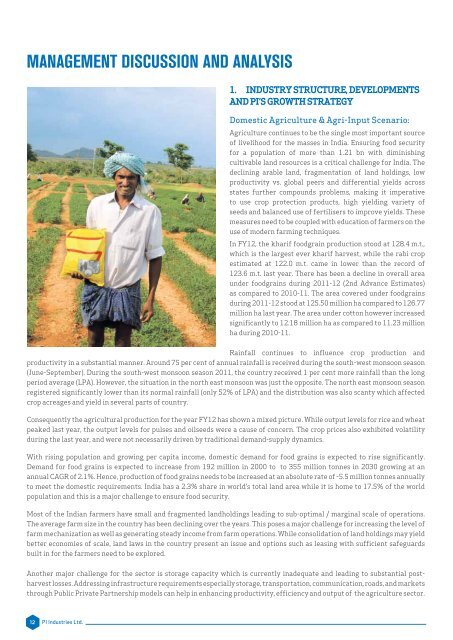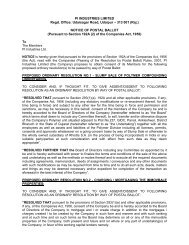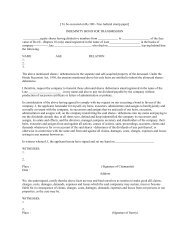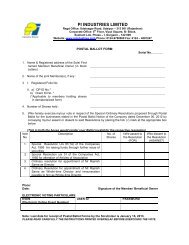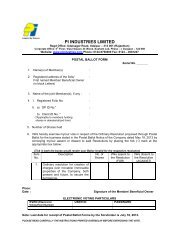Annual Report FY 2011-12 - PI Industries
Annual Report FY 2011-12 - PI Industries
Annual Report FY 2011-12 - PI Industries
Create successful ePaper yourself
Turn your PDF publications into a flip-book with our unique Google optimized e-Paper software.
MANAGEMENT DISCUSSION AND ANALYSIS<br />
1. INDUSTRY STRUCTURE, DEVELOPMENTS<br />
AND <strong>PI</strong>’S GROWTH STRATEGY<br />
Domestic Agriculture & Agri-Input Scenario:<br />
Agriculture continues to be the single most important source<br />
of livelihood for the masses in India. Ensuring food security<br />
for a population of more than 1.21 bn with diminishing<br />
cultivable land resources is a critical challenge for India. The<br />
declining arable land, fragmentation of land holdings, low<br />
productivity vs. global peers and differential yields across<br />
states further compounds problems, making it imperative<br />
to use crop protection products, high yielding variety of<br />
seeds and balanced use of fertilisers to improve yields. These<br />
measures need to be coupled with education of farmers on the<br />
use of modern farming techniques.<br />
In <strong>FY</strong><strong>12</strong>, the kharif foodgrain production stood at <strong>12</strong>8.4 m.t.,<br />
which is the largest ever kharif harvest, while the rabi crop<br />
estimated at <strong>12</strong>2.0 m.t. came in lower than the record of<br />
<strong>12</strong>3.6 m.t. last year. There has been a decline in overall area<br />
under foodgrains during <strong>2011</strong>-<strong>12</strong> (2nd Advance Estimates)<br />
as compared to 2010-11. The area covered under foodgrains<br />
during <strong>2011</strong>-<strong>12</strong> stood at <strong>12</strong>5.50 million ha compared to <strong>12</strong>6.77<br />
million ha last year. The area under cotton however increased<br />
significantly to <strong>12</strong>.18 million ha as compared to 11.23 million<br />
ha during 2010-11.<br />
Rainfall continues to influence crop production and<br />
productivity in a substantial manner. Around 75 per cent of annual rainfall is received during the south-west monsoon season<br />
(June-September). During the south-west monsoon season <strong>2011</strong>, the country received 1 per cent more rainfall than the long<br />
period average (LPA). However, the situation in the north east monsoon was just the opposite. The north east monsoon season<br />
registered significantly lower than its normal rainfall (only 52% of LPA) and the distribution was also scanty which affected<br />
crop acreages and yield in several parts of country.<br />
Consequently the agricultural production for the year <strong>FY</strong><strong>12</strong> has shown a mixed picture. While output levels for rice and wheat<br />
peaked last year, the output levels for pulses and oilseeds were a cause of concern. The crop prices also exhibited volatility<br />
during the last year, and were not necessarily driven by traditional demand-supply dynamics.<br />
With rising population and growing per capita income, domestic demand for food grains is expected to rise significantly.<br />
Demand for food grains is expected to increase from 192 million in 2000 to to 355 million tonnes in 2030 growing at an<br />
annual CAGR of 2.1%. Hence, production of food grains needs to be increased at an absolute rate of ~5.5 million tonnes annually<br />
to meet the domestic requirements. India has a 2.3% share in world’s total land area while it is home to 17.5% of the world<br />
population and this is a major challenge to ensure food security.<br />
Most of the Indian farmers have small and fragmented landholdings leading to sub-optimal / marginal scale of operations.<br />
The average farm size in the country has been declining over the years. This poses a major challenge for increasing the level of<br />
farm mechanization as well as generating steady income from farm operations. While consolidation of land holdings may yield<br />
better economies of scale, land laws in the country present an issue and options such as leasing with sufficient safeguards<br />
built in for the farmers need to be explored.<br />
Another major challenge for the sector is storage capacity which is currently inadequate and leading to substantial postharvest<br />
losses. Addressing infrastructure requirements especially storage, transportation, communication, roads, and markets<br />
through Public Private Partnership models can help in enhancing productivity, efficiency and output of the agriculture sector.<br />
<strong>12</strong><br />
<strong>PI</strong> <strong>Industries</strong> Ltd.


